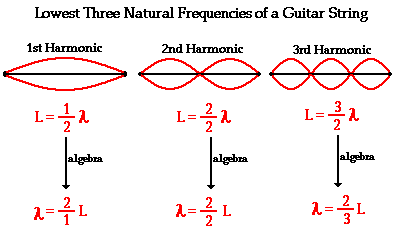Harmonics / Natural Frequencies
In the previous section, the
frequency that was calculated was for the first
harmonic of the wave. In other words, we only
considered waves for each string that had only two
nodes (one at both ends of the guitar) and one
anti-node (in the middle of the string) for each
string. As you press down on the string at a
specific fret, you are essentially changing the
length of the string, but you are still only hearing
the first harmonic for that specific string with
that certain mass, length, tension, etc. Even though
this is the fundamental idea behind the frets of a
guitar, there is still another way we can change the
frequency of each string without changing the
length; we can change the wavelength!
This may seem puzzling at first, but we can very
easily change the wavelength by using the idea of
harmonics. In essence, harmonics are the natural
frequencies that will naturally vibrate for a given
guitar string. There are several different harmonics
for each of the 6 strings on a guitar, but
essentially, each harmonic is determined by
multiplying the wavelength by n/2, where n
is an integer value.
Below is an image depicting this very simple idea of
harmonics.

http://www.physicsclassroom.com/class/sound/Lesson-5/Guitar-Strings
By placing a node in the middle of an open
string and creating a wave, you are producing the
2nd harmonic for that certain string with its
specific qualities. This can easily be done by
gently placing your finger against the string at
certain spots. You do not want to press down on the
string, because you will then either mute the wave
with your finger, or (if you press all the way down
to the fretboard), you will change the length of the
string, and create a different frequency all
together. When you are playing harmonics on the
guitar, you only want to gently rest your finger on
the string in the desired position to create a node
at that spot on the wave (like shown in the image
above).
Below is a chart showing multiple positions on each
string where a certain harmonic can be produced, and
the note that results from it. This chart is based
on a guitar with standard tuning (E, A, D, G, B, E),
and with the lowest string at the bottom of the
image.

http://www.all-guitar-chords.com/topic.php?id=5125
|